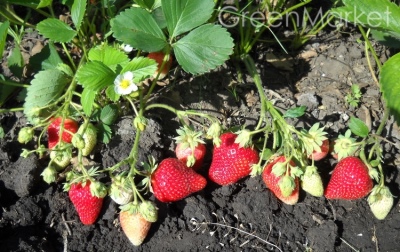
- Authors: England, Kent South-East, Edward Vinson
- Name synonyms: Eve's Delight
- Taste: dessert
- The size: large
- Weight: from 20 g
- Yield rate: high
- Yield: 1-2kg per bush
- Repairability: Yes
- Advantages: long-term storage of berries
- Appointment: universal
The Evis Delight variety is very popular among summer residents and gardeners. He fell in love with them for the fact that it can be grown and bring a large harvest in areas with a harsh climate, as well as bear fruit several times over the summer.
Breeding history of the variety
The Evis Delight strawberry variety was developed in the south-east of England in Kent. The author is Edward Vinson. A synonym for the culture name Eve's Delight.
Description of the variety
A multi-purpose strawberry variety. The bushes of the culture are medium-sized, rather compact, low-leafed. The leaves are large, light green, slightly corrugated. The flowers are white, very large. Peduncles are strong, high, towering above the leaves. They have the ability not to bend while supporting the weight of the berries. The ability to formulate is small. They have a very large root system.
Ripening terms
The variety of this strawberry is referred to as medium ripening. The fruiting period of the culture is from mid-June to frost.
Growing regions
Since the plant can winter well, it is grown in the Kamchatka Territory, in Moscow, Moscow Region, Central and northern regions of Russia.
Yield
Avis Delight belongs to the remontant variety and has a high yield. The plant produces crops all summer long. One bush can produce about 1-2 kg of berries.
Berries and their taste
The berries of the culture have an aligned, blunt-conical shape. The fruits are very large, deep red in color. The mass of the berry is from 20 g, fruits of a larger mass are also found. The consistency of the pulp is dense, light red in color. The fruits have a rich aroma and dessert taste. Tasting score on a 5-point system - 5 points. The fruits have good transportability and retain their appearance unchanged for a long time.
Growing features
A favorable time for planting a culture is spring or autumn. Bushes are planted at the rate of 4 bushes per 1 square meter. If planting in rows is used, then the distance between the plants should be at least 30 cm, and between the rows - at least 0.5 m. After the plant is planted, the soil is watered and mulched.
When growing a crop, you must follow standard care measures. Strawberries need moderate watering, which should be done regularly. During the period when the plant is blooming, you need to water every other day, preferably in the morning or in the evening.
Experienced gardeners grow strawberries using black agrofibre. It significantly reduces the frequency of watering and loosening, and interferes with the growth of weeds and vegetation. If no fiber is used, the soil must be loosened every time a crust forms on the soil after watering.
It is necessary to closely monitor the formation of the mustache. If the plant is not intended for reproduction, then the extra mustache must be removed so that they do not interfere with the normal growth of the bushes. In one place, strawberries can be grown for no more than 2 years.




Site selection and soil preparation
A correctly chosen area for planting strawberries allows for normal growth and high yields. The landing site should be leveled with a slight slope. The plot is well lit by sunlight, no shading.
The soil for cultivation must be fertile and loose. The desired acidity level is not higher than 5.5 pH. From digging the site to planting, at least 30 days must pass. After the soil is dug up, organic and superphosphate fertilizers are introduced into it.

Pollination
The Evis Delight strawberry is pollinated with bisexual flowers.
Top dressing
You need to feed this variety throughout the summer. The first feeding is done in early spring with fertilizers containing nitrogen. In the summer, strawberries are fed once every 1.5 weeks, potash and phosphorus fertilizers are applied.

One of the important techniques in strawberry care is feeding. Regular fertilization guarantees a rich harvest. There are several different ways to feed strawberries, and each of them is designed for a specific period of plant development. During flowering, fruiting and after it, feeding should be different.
Frost resistance and the need for shelter
The strawberry variety is adapted to growth in adverse weather conditions, therefore it belongs to the winter hardy. In areas where winter has a large snow cover, the plant can survive without shelter at temperatures down to -30 degrees.

Diseases and pests
The Evis Delight strawberry variety is well adapted to various diseases. If, nevertheless, the disease has occurred, then it may be gray or white rot. The peculiarity of the plant is that it has a high resistance to powdery mildew.
And also the culture can be affected by various pests: weevil, strawberry leaf beetle and tick, slugs, aphids, bear.To make pests less likely to harm the bushes, you need to observe regular spraying with special solutions.

Strawberries are often subject to many dangerous diseases that can seriously undermine their condition. Among the most common are powdery mildew, gray mold, brown spot, anthracnose, and verticillosis. Before buying a variety, you need to inquire about its disease resistance.
Reproduction
Strawberry Evis Delight has a slight permeation, so you need to think about reproduction in advance. To do this, you should choose the bushes, which in the future will form shoots. In practice, pinching of peduncles is used so that they accelerate the formation of a mustache. And also a popular breeding method is to divide the bush.

Review overview
Gardeners and summer residents leave only good reviews about the variety. Strawberries are appreciated for their high yields, ease of care and the ability to winter even in very harsh climates.


















































































